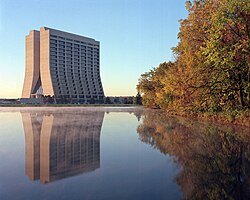
Back مكشاف مصادم فيرميلاب Arabic Collider Detector at Fermilab German Collider Detector at Fermilab French Collider Detector at Fermilab Italian Detector de colisões do Fermilab Portuguese Collider Detector at Fermilab Slovak Fermilab'daki çarpıştırma dedektörü Turkish


The Collider Detector at Fermilab (CDF) experimental collaboration studies high energy particle collisions from the Tevatron, the world's former highest-energy particle accelerator. The goal is to discover the identity and properties of the particles that make up the universe and to understand the forces and interactions between those particles.
CDF is an international collaboration that, at its peak, consisted of about 600 physicists[1] (from about 30 American universities and National laboratories and about 30 groups from universities and national laboratories from Italy, Japan, UK, Canada, Germany, Spain, Russia, Finland, France, Taiwan, Korea, and Switzerland).[2] The CDF detector itself weighed about 5000 tons[3] and was about 12 meters in all three dimensions. The goal of the experiment is to measure exceptional events out of the billions of particle collisions in order to:
- Look for evidence for phenomena beyond the Standard Model of particle physics
- Measure and study the production and decay of heavy particles such as the top and bottom quarks, and the W and Z bosons
- Measure and study the production of high-energy particle jets and photons
- Study other phenomena such as diffraction[2]
The Tevatron collided protons and antiprotons at a center-of-mass energy of about 2 TeV. The very high energy available for these collisions made it possible to produce heavy particles such as the top quark and the W and Z bosons, which weigh much more than a proton (or antiproton). These heavier particles were identified through their characteristic decays.[4] The CDF apparatus recorded the trajectories and energies of electrons, photons and light hadrons. Neutrinos did not register in the apparatus, which led to an apparent missing energy.[5]
There is another experiment similar to CDF called DØ which had a detector located at another point on the Tevatron ring.
- ^ Toback, David (2017-06-30). "CDF publishes 700 papers". Fermilab - News at Work. Archived from the original on 2018-10-22. Retrieved 2021-01-05.
- ^ a b Yoh, John (2005-04-20). "Brief Introduction to the CDF Experiment". The Collider Detector at Fermilab. Archived from the original on 2004-12-04. Retrieved 2020-01-05.
- ^ Browne, Malcolm W. (1995-03-01). "Top Quark Remains a Mystery, but Only for One More Day (Published 1995)". The New York Times. ISSN 0362-4331. Retrieved 2021-01-05.
- ^ Denisov, Dmitri; Konigsberg, Jacobo (2016-04-15). "The Tevatron legacy: a luminosity story". CERN Courier. Archived from the original on 2020-06-23. Retrieved 2021-03-12.
- ^ Yoh, John (January 7, 2005). "Introduction to the CDF Detector and the Particles We Observe". The Collider Detector at Fermilab. Archived from the original on 2004-12-04. Retrieved March 12, 2021.